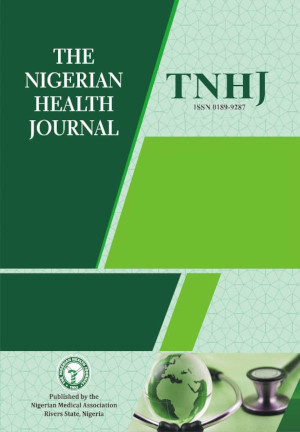Patterns of Adult Congenital Heart Diseases at The Rivers State University Teaching Hospital
DOI:
https://doi.org/10.71637/tnhj.v25i1.1052Keywords:
Congenital heart defects, CHD, adult congenital heart diseases, ACHD, Nigeria, retrospective review, cyanotic CHDs, acyanotic atrial septal aneurysm, patent ductus arteriosus, Tetralogy of FallotAbstract
Background: Adult Congenital heart defects (CHD) describe heart diseases present at birth. that persist into adulthood, and those corrected at childhood that have hemodynamic deficits requiring the attention of the adult cardiologists who manage complications such as pulmonary hypertension or surgical issues. There is paucity of studies on the Prevalence of Adult Congenital Heart Disease in Nigeria. This study aims to provide insights into adult congenital heart diseases (ACHD) at the Rivers State University Teaching Hospital
Methods: A retrospective review was conducted using data from the Rivers State University Teaching Hospital, Echocardiogram laboratory for a period of one year: from December 2022 to December 2023. The study involved 23 adult patients with confirmed CHD diagnoses. Data were collected from patient case notes and analyzed for demographic and clinical features and Echocardiogram diagnosis.
Results: The study included 23 adult patients with a mean age of 52.4 ± 22.1 years. The gender distribution was slightly female dominated (65.2%). CHDs were categorized into cyanotic and acyanotic types, with acyanotic defects being more prevalent (87.0%). The most common CHDs were atrial septal aneurysms (52.2%) and patent ductus arteriosus (13.0%). Cyanotic CHDs, such as Tetralogy of Fallot (TOF) and univentricular heart, accounted for 13.0% of patients.
Conclusion: The high prevalence of acyanotic CHDs and the significant occurrence of cyanotic CHDs highlight the need for specialized care and monitoring of ACHD patients in Nigeria. Improved health facilities, early diagnosis, and advanced interventional procedures are essential for managing ACHD effectively.
Downloads
References
1. Hoffman JI, Kaplan S. The incidence of congenital heart disease. J Am Coll Cardiol. 2002;39(12):1890-900.
2. Reller MD, Strickland MJ, Riehle-Colarusso T, Mahle WT, Correa A. Prevalence of Congenital Heart Defects in Metropolitan Atlanta, 1998-2005. J Pediatr. 2008;153(6):807-813.
3. Thomas MO, Olusoji O, Awolola N. Spectrum of congenital heart diseases in an African population: A necropsy study. World J Cardiovasc Dis. 2013;3(1):8-13.
4. Antia AU. Congenital heart disease in Nigeria. Clinical and necropsy study of 260 cases. Arch Dis Child. 1974 Jan;49(1):36-9. doi: 10.1136/adc.49.1.36. PMID: 4818090; PMCID: PMC1648854.
5. Otaigbe BE, Tabansi PN. Congenital heart disease in the Niger Delta region of Nigeria: A four-year prospective echocardiographic analysis. Cardiovasc J Afr. 2014;25(6):265-268. doi:10.5830/CVJA-2014-055.
6.Amaewhule O, Otaigbe BE, Opara PI. Prevalence of Congenital Heart Defects among Neonates in Port Harcourt, Rivers State, Nigeria. Journal of Hypertension and Cardiology. 2022.
7. Abdulkadir M, Abdulkadir Z. A systematic review of trends and patterns of congenital heart disease in children in Nigeria from 1964-2015. Afr Health Sci. 2016;16(3):497-508.
8. Ujuanbi AS, Tabansi PN, Otaigbe BE. Prevalence of congenital heart diseases among primary school children in the Niger Delta Region of Nigeria, West Africa. J Cardiol Cardiovasc Med. 2022;8(2):121-7.
9. Stout KK, Daniels CJ, Aboulhosn JA, Bozkurt B, Broberg CS, Colman JM, et al. 2018 AHA/ACC guideline for the management of adults with congenital heart disease: a report of the American College of Cardiology/American Heart Association Task Force on Clinical Practice Guidelines. Circulation. 2019;139(14):e698–800.
10. Jenkins KJ, Correa A, Feinstein JA, Botto L, Britt AE, Daniels SR, et al. Noninherited risk factors and congenital cardiovascular defects: current knowledge: a scientific statement from the American Heart Association Council on Cardiovascular Disease in the Young. Circulation. 2007;115(23):2995-3014.
11. Van der Linde D, Konings EE, Slager MA, Witsenburg M, Helbing WA, Takkenberg JJ, et al. Birth prevalence of congenital heart disease worldwide: a systematic review and meta-analysis. J Am Coll Cardiol. 2011;58(21):2241-7.
12. Mulder BJM. Epidemiology of adult congenital heart disease: demographic variations worldwide. Neth Heart J. 2012;20(12):505-15.
13. Ejim EC, Anisiuba BC, Oguanobi NI, Ubani-Ukoma BC, Nwaneli UC, Ugwu C, Ike SO. Congenital Heart Diseases in Adults: A Review of Echocardiogram Records in Enugu, South-East Nigeria. Ann Med Health Sci Res. 2014;4(3):345-349. doi:10.4103/2141-9248.139297.
14. Nwalibe C, Effiom VB, Anyinkeng ABS, et al. Assessment of the financial gaps in cardiothoracic surgery in Africa. Interdisciplinary CardioVascular and Thoracic Surgery (ICVTS). 2024 available from https://academic.oup.com/icvts. Cited 2025 Mar 19.
15. Abubakar IS, Abdullahi LH, Bala AU, Rabiu AT, Ahmad RM. Achieving cardiac surgery independence in Nigeria: The role of sustainable local training programs. World J Surg. 2018;42(4):951-8.
16. International Society for Adult Congenital Heart Disease (ISACHD). Available from: ISACHD. www. https://www.isachd.org cited 2025 Mar 19
17. Ekure EN, Bode-Thomas F, Sadoh WE, et al. Congenital Heart Defects in Nigerian Children: Preliminary Data from the National Pediatric Cardiac Registry. World Journal for Pediatric & Congenital Heart Surgery. 2017 Nov;8(6):699-706. DOI: 10.1177/2150135117725457. PMID: 29187100.
18. Ekure EN, Bode-Thomas F, Sadoh WE, et al. Congenital Heart Defects in Nigerian Children: Preliminary Data from the National Pediatric Cardiac Registry. World Journal for Pediatric & Congenital Heart Surgery. 2017 Nov;8(6):699-706. DOI: 10.1177/2150135117725457. PMID: 29187100.
19. Chinawa JM, Chinawa AT, Uwaezuoke NA, Igoche PD. The variability in pattern, presentation, and outcomes in the management of congenital corrected transposition of the great artery (ccTGA): A Systematic Review and Meta-analysis. Niger Med J. 2024;65(2):123-130. doi: 10.4103/nmj.nmj_123_24.
20. Liu Y, Chen S, Zühlke L, Black GC, Choy MK, Li N, Keavney BD. Global birth prevalence of congenital heart defects 1970–2017: updated systematic review and meta-analysis of 260 studies. Int J Epidemiol. 2019;48(2):455-463. doi:10.1093/ije/dyz009.
21. Zhao L, Chen L, Yang T, Wang T, Zhang S, Chen L, Ye Z, Luo L, Qin J. Birth prevalence of congenital heart disease in China, 1980–2019: a systematic review and meta-analysis of 617 studies. Eur J Epidemiol. 2020;35(6):631-642. doi:10.1007/s10654-020-00653-0.
22. Samánek M, Boyadjiev S, Pavelka K, Fetkovska N, Šamánek A. Gender differences in the incidence of congenital heart disease: A prospective nationwide study. Heart. 1998;80(4):456-60.
23. Lammers AE, Hislop AA, Flynn Y, Haworth SG. The influence of gender and somatic growth on the outcome of congenital heart defects in children and young adults. Heart. 2007;93(4):458-63.
24. Egbe AC, Connolly HM, Miranda WR, Ammash NM, Hagler DJ. Gender differences in outcomes after congenital heart disease surgery: A nationwide study. J Am Coll Cardiol. 2020;75(3):527-37.
25. Marino BS, Lipkin PH, Newburger JW, Peacock G, Gerdes M, Gaynor JW, et al. Neurodevelopmental outcomes in children with congenital heart disease: Evaluation and management. Circulation. 2012;126(9):1143-72.
26. Van der Linde D, Konings EE, Slager MA, Witsenburg M, Helbing WA, Takkenberg JJ, et al. Birth prevalence of congenital heart disease worldwide: A systematic review and meta-analysis. J Am Coll Cardiol. 2011;58(21):2241-7.
30. Ejim EC, Ike SO, Anisuba BC, Onwubere BJ, Ikeh VO. Ventricular septal defect at University of Nigeria Teaching Hospital, Enugu: A review of echocardiographic records. Trans R Soc Trop Med Hyg. 2009;103(2):159-61.
31. Persson M, Razaz N, Edstedt Bonamy A, Villamor E, Cnattingius S. Maternal overweight and obesity and risk of congenital heart defects. J Am Coll Cardiol. 2019;73(1):44-53.
32. Ogundare JO, Adeleke O, Ayodele AA. Challenges in delivering cardiovascular services for congenital heart diseases in Nigeria. Int J Cardiovasc Res. 2021;15(2):45-51.
33. Ndungu JM, Mubangizi DB, Nansseu JR, Noubiap JJ. Prevalence and patterns of congenital heart diseases in Africa: A systematic review and meta-analysis. BMJ Open. 2017;7(2):e015633.
34. Zühlke L, Mirabel M, Marijon E. Congenital heart disease and rheumatic heart disease in Africa: Recent advances and current priorities. Heart. 2013;99(21):1554-61.
35. Agmon Y, Khandheria BK, Meissner I, Gentile F, Whisnant JP, Sicks JD, O'Fallon WM, Covalt JL, Wiebers DO, Seward JB. Frequency of atrial septal aneurysms in patients with cerebral ischemic events. Circulation. 1999 Apr 20;99(15):1942-4. doi: 10.1161/01.cir.99.15.1942. PMID: 10208995.
36. Lucas C, Goullard L, Marchau M Jr, Godefroy O, Rondepierre P, Chamas E, Mounier-Vehier F, Leys D. Higher prevalence of atrial septal aneurysms in patients with ischemic stroke of unknown cause. Acta Neurol Scand. 1994 Mar;89(3):210-3. doi: 10.1111/j.1600-0404. 1994.tb01663. x. PMID: 8030403.
37. A.V Mattioli, M Aquilina, A Oldani, C Longhini, G Mattioli, Atrial septal aneurysm as a cardioembolic source in adult patients with stroke and normal carotid arteries. A multicentre study, European Heart Journal, Volume 22, Issue 3, 1 February 2001, Pages 261–268, https://doi.org/10.1053/euhj.2001.229
38. Slam AKM, Majumder AAS, Rahman MA, Shimu IJ, Chowdhury TA, Ullah M, Hossain MD, et al. Prevalence of atrial septal aneurysm in Bangladeshi subjects: analysis of 2598 subjects by echocardiography. [Internet]. Dhaka: NICVD; [cited 2025 Mar 20]. https://cardiologybd.com/journal/
39. Messé SR, Kasner SE, Connolly HM, et al. Patent foramen ovale and cryptogenic stroke: evaluation and management. Circulation [Internet]. 2024 Nov 22 [cited 2025 Mar 20];130(12):1127-42. Available from: https://doi.org/10.1161/CIR.130.12.1127

Published
Issue
Section
License
Copyright (c) 2025 Stella Ngozi Cookey, Rita Wakama, Deinma Asikimabo-Ofori, Bonas Harry

This work is licensed under a Creative Commons Attribution-NonCommercial-ShareAlike 4.0 International License.
The Journal is owned, published and copyrighted by the Nigerian Medical Association, River state Branch. The copyright of papers published are vested in the journal and the publisher. In line with our open access policy and the Creative Commons Attribution License policy authors are allowed to share their work with an acknowledgement of the work's authorship and initial publication in this journal.
This is an open access journal which means that all content is freely available without charge to the user or his/her institution. Users are allowed to read, download, copy, distribute, print, search, or link to the full texts of the articles in this journal without asking prior permission from the publisher or the author.
The use of general descriptive names, trade names, trademarks, and so forth in this publication, even if not specifically identified, does not imply that these names are not protected by the relevant laws and regulations. While the advice and information in this journal are believed to be true and accurate on the date of its going to press, neither the authors, the editors, nor the publisher can accept any legal responsibility for any errors or omissions that may be made. The publisher makes no warranty, express or implied, with respect to the material contained herein.
TNHJ also supports open access archiving of articles published in the journal after three months of publication. Authors are permitted and encouraged to post their work online (e.g, in institutional repositories or on their website) within the stated period, as it can lead to productive exchanges, as well as earlier and greater citation of published work (See The Effect of Open Access). All requests for permission for open access archiving outside this period should be sent to the editor via email to editor@tnhjph.com.





